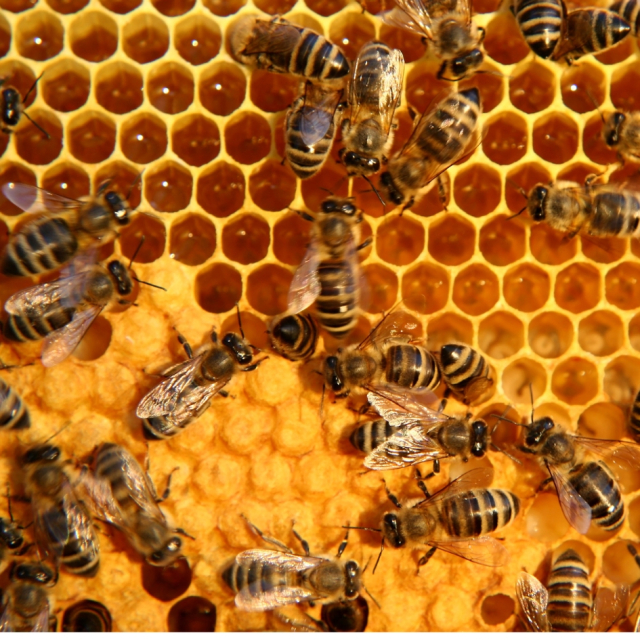Bees have been essential companions of humans and nature for millennia. From their contribution to pollination to their relevance in food production and ecosystems, these insects are fundamental to biodiversity and environmental balance. However, in recent decades, bees have faced threats that endanger their existence and, with it, the stability of the ecosystems that depend on them.
Characteristics and biology of bees.
Bees are insects belonging to the order Hymenoptera and the family Apidae . This group includes species such as honey bees ( Apis mellifera ), bumblebees, and solitary bees. Although the honey bee is the best known for its social organization and honey production, there are more than 20,000 species distributed throughout the world, except at the poles.
A honey bee hive is a perfect model of social cooperation. There are three main types of individuals in it:
- The queen : She is the only fertile female responsible for laying the eggs.
- Workers : Sterile females responsible for collecting food, building honeycombs and caring for the young.
- Drones : Males whose only function is to fertilize the queen.
The life cycle of a bee begins with the egg, followed by a larval stage, pupa and finally adult. This process is completed in less than a month, allowing colonies to renew themselves quickly.
Ecological and agricultural functions.
Bees are the main pollinators on the planet. Through the process of pollination, they transfer pollen between flowers, facilitating the fertilization and reproduction of plants. This ecological service is essential for the survival of many plant species and for food production.
- Agricultural Production : More than 70% of agricultural crops depend on bee pollination. Fruits such as apples, almonds and blueberries, along with crops such as pumpkins and coffee, need pollinators to achieve optimal harvest. .
- Biodiversity : Bee-pollinated plants not only feed humans, but also a wide range of animals. In addition, healthy habitats depend on pollination to maintain an ecological balance. .
- Maintaining wild ecosystems : Many wild plants rely exclusively on bees to reproduce. This ensures the stability of ecosystems and protects against soil erosion and extreme climate changes.
Additional benefits: Honey, wax and propolis.
In addition to pollination, bees are known for producing honey, a natural food rich in nutritional and medicinal properties. They also produce wax, used in cosmetics, pharmaceuticals and candles, and propolis, a resin used in medicinal treatments for its antimicrobial properties.
Current threats.
In recent decades, bees have experienced an alarming decline in their populations due to factors such as:
- Pesticide use : Chemical pesticides, especially neonicotinoids, affect the nervous system of bees, reducing their ability to navigate and collect nectar. .
- Habitat loss : Urban expansion and monocultures have significantly reduced the spaces where bees can nest and feed. .
- Climate change : Changes in weather patterns affect plant flowering and limit access to food sources.
- Pests and diseases : Parasites such as Varroa destructor and viral diseases are a constant threat to colonies. .
Impact on food security and biodiversity.
Declining bee populations have serious consequences. Reduced pollination can lead to lower crop production, affecting both the availability and quality of food. This, in turn, increases agricultural costs and reduces food security, especially in regions with a high dependence on pollinated crops.
In addition, the loss of pollinators affects biodiversity in general. Plants that fail to reproduce negatively impact the habitats of other animals, creating a chain reaction that puts the stability of ecosystems at risk.
Strategies for conservation.
It is essential to take action at global and local levels to protect bees and ensure their survival. Some strategies include:
- Reducing pesticide use : Promote sustainable agricultural practices and stricter regulations on the use of harmful chemicals.
- Creating friendly habitats : Plant native flowers and establish ecological corridors for bees to find shelter and food.
- Supporting sustainable beekeeping : Encouraging responsible beekeeping can help maintain bee populations.
- Education and awareness : Raising awareness among the population about the importance of bees and the dangers they face is key to mobilizing action.
The role of each individual in protecting bees
Each person can contribute to the care of bees by adopting simple practices:
- Grow flowers and plants that attract pollinators.
- Avoid the use of pesticides and opt for natural alternatives.
- Support local honey products, which often come from beekeepers committed to sustainability.
Bees are essential to life on Earth, not only as honey producers, but also as they perform an irreplaceable ecological service: pollination. Without them, food security and biodiversity would face a monumental challenge. Protecting bees is not only a matter of environmental preservation, but a necessity to ensure the well-being of future generations.
References:
